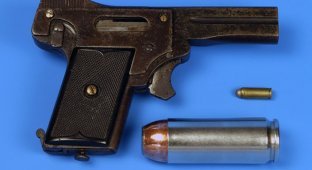There are few people who have not heard of the legendary Mauser pistol. Thanks to literary works and films about the Civil War and Revolution, in the Russian country this pistol, together with a leather jacket, became a recognizable calling card of commissars and security officers everywhere and bore the proud name “Comrade Mauser.”

The design of the Mauser C-96 pistol was developed in 1893 by brothers Fidel, Friedrich and Josef Feederle (Fidel, Friedrich, Josef Feederle) and improved together with Paul Mauser and gunsmith Gaiser. The finishing work was completed in 1895. At the same time, production of a trial batch began. On March 15, 1895, the pistol was demonstrated to Kaiser Wilhelm II. Paul Mauser patented the design in his name, receiving Reichspatent No. 90430 on September 11, 1895. Another patent was received in the UK. The official name of the pistol given by its manufacturer is “Mauser-Selbstlade-Pistole”, which translated means “Mauser self-loading pistol”. Since the beginning of production in 1910 of the pocket Mauser chambered for 6.35×15.5 HR, the pistol began to be called “C-96” (Construktion 96 - design of the 96th year). It should be clarified that this name was used only by sellers and importers. At the Mauser company, the pistol was still called “Mauser-Selbstlade-Pistole”. Another official name is Model 1930. Other modifications have unofficial names, for example “Model 1912” or “Bolo”.

The new weapon had several distinctive features. A permanent double-row magazine with a capacity of 10 rounds was placed in front of the trigger guard and was loaded with cartridges from plate clips. The pistol was held using a round conical handle with grooves for attaching a wooden butt holster. The C-96 received the nickname "Broomhandle", which means "broom handle", precisely because of the shape of the handle. The sector sight was designed for shooting up to 1000 meters. For this pistol, a new 7.63×25 Mauser cartridge was developed, the design of which was based on the 7.65 mm Borchardt cartridge, but with an elongated sleeve and an increased powder charge. The initial bullet speed was 430 m/s, which was a record among pistols of that time. In addition, Mausers were produced chambered for 9mm Parabellum and, in small quantities, chambered for 9mm Mauser Export (9?25).
![]()
Before considering the design and history of this weapon, let's take a look at the various versions of the pistol. Waffenfabrik Mauser A.G. repeatedly modernized the C-96 design, subjecting it to a variety of, usually minor, changes. The largest number of modifications were created in the early period of production - from 1896 to 1905. They changed the length of the barrel, the capacity and shape of the magazine, the shape of the handle, the shape of the trigger, the grooves on the frame and the external finish. Some variants differ only in the location of the serial number. In total, collectors counted more than 130 different versions of the Mauser-Selbstlade-Pistole. The most popular type of early release is the model with a conical hammer, the so-called “Cone Hammer”. The main distinguishing feature is the trigger with conical cheeks. The pistol was produced with a 10-round magazine, a 140 mm barrel, and a sector sight marked at a distance of 50 to 1000 meters. There are also pistols with magazines with a capacity of 6 and 20 rounds. Approximately 16,000 Cone Hammer pistols were produced.
Mauser "Cone Hammer" pistol
![]()
The next popular option from the early release is a model with a large hole trigger. It was called the “Large Ring Hammer,” which means “Trigger with a large ring.” The released trigger blocked the aiming line. Most of the options belong to this variety. The most popular of them is the “Flat Side” pistol, commissioned by the Italian Navy. The model received this name because of the flat side surfaces of the frame, without milled grooves. During this period, the first shortened versions appeared with a smaller handle, a 100 mm barrel and a magazine with a capacity of 6 rounds. In total, about 25,000 copies of the Large Ring type pistols were produced.
Mauser C-96 “Large Ring Hammer” pistol, 1899
![]()
Mauser “Large Ring Hammer” in the “Flat Side” version, commissioned by the Italian Navy
![]()
Mauser "Small Ring Hammer" pistol
![]()
By 1905, pistol production had stabilized in terms of variations. Now only two main modifications were produced - full-size and shortened pistols. The exception was the release of a small number of full-size pistols chambered for the 9mm Mauser Export cartridge. One of the most famous pre-war versions was a pistol with a hammer with a small hole, called the “Small Ring Hammer”. In addition to the trigger with a “small ring,” the weapon received a slightly modified safety lock. In early models, such as the Tapered Trigger or the Big Ring Trigger, the safety lever's top position is on and the safety lever's bottom position is off. The "small ring trigger" and all later models have a reverse safety. In addition, the long ejector used in early models has been replaced with a short one.

Issued between 1912 and 1918. pistols are classified as military issue. The reason is that in 1912 a new safety design was introduced - “Neue Sicherung”, and it is impossible to determine by the number whether such a pistol was produced in 1912 or 1915 due to the lack of archives. The new fuse was abbreviated as "NS". This monogram was made on the back surface of the trigger. The fuse head is made without a through hole. The "Small Ring" model sights with the "Neue Sicherung" safety were not marked "900". About 130,000 of these pistols were produced.
C-96 with "Neue Sicherung" fuse (Model 1912)
![]()
Mauser C-96 “Red Nine” pistol with attached holster-stock
![]()
The Mauser C-96 “Red Nine” pistol is a conversion of the standard 9mm Parabellum cartridge, distinguished by large numbers “9”, with red paint, on the sides of the grip cheeks
![]()
In 1916, Prussia made the Waffenfabrik Mauser A.G. order for 150,000 pistols chambered for the standard 9mm Parabellum cartridge. This version of the 96th was later called the “Red Nine” (Red Nine) for the large number “9”, painted over with red varnish, present on the cheeks of the handle of these pistols, so that they could be easily visually distinguished from weapons of 7.63 caliber mm. In addition to the caliber, these pistols were distinguished by a sight marked from 50 to 500 meters. The stamp of the Prussian Army Reception Commission was placed on the right side of the chamber. After 1917, such pistols were equipped with a recess in the feeder for greater operational reliability. It should be noted here that after World War II, a large number of 7.63 mm pistols were converted to the 9 mm cartridge. Pistols issued under the Prussian Contract are distinguished by the mark of the Army Acceptance Committee on the right side of the chamber, the hammer with the stamp “NS” and “Small Ring”, as well as walnut cheeks with 24 grooves and a carved “9”.
Models of the post-war period include pistols produced from 1920 to 1937. The earliest version of the post-war Mauser is the Model 1920. In the conditions of post-war devastation in Germany in the 1918-1920s, Mauser factories did not produce their famous pistols, but from 1920 they began to remake old pistols for the police. Under the terms of the Versailles Peace Treaty of 1919, Germany was prohibited from producing pistols with a barrel length of more than 100 mm and a caliber of more than 8 mm. As a result, a wide variety of C-96 variants were redesigned by shortening the barrel. Such pistols can be distinguished by their 99 mm long barrel and the “1920” stamp on the receiver or frame. But a small number of 7.63 mm and 9 mm pistols with 140 mm barrels were also produced. Sometimes a P.08 type front sight was attached to the cut barrel. The “Red Nines” were also redesigned by installing a 99 mm barrel of 7.63 mm caliber, as well as a non-adjustable rear sight instead of the one marked up to 500 meters.
Mauser of the post-war period, manufactured in 1920, with a 99 mm long barrel and the stamp “1920”, converted from a “Red Nine” pistol of the Prussian order
![]()
One of the most famous variants of the shortened C-96 was the Mauser "Bolo". In 1922, Mauser again began production of a shortened version of the C-96. The largest customer of such Mausers was Soviet Russia. Two batches of 5,000 and 15,000 copies were purchased, which were used by the NKVD and the Red Army. Such pistols are distinguished by 99 mm long barrels, 7.63 mm caliber, a shortened handle with walnut cheeks with 22 grooves, and a “Small Ring Hammer” trigger with the “NS” stamp. But the main difference between the post-war shortened Bolo Mausers is the horizontally swinging swivel on the handle.
The Model 1930 is the only C-96 pistol to have its own name given to it by its manufacturer. This variant began to be produced in 1930 after the production of the shortened "Bolo" ceased. To reduce production costs, as well as increase reliability and safety, a number of changes were made to the design of this weapon. Initially, the pistols were equipped with 132 mm long barrels, but then returned to the classic 140 mm barrel. The Model 1930 can be easily identified by the transition on the barrel with a thicker chamber area. The pistol received a new design fuse, which, when turned on, safely released the hammer from cocking, without contact with the firing pin. The shape of the “Small Ring Hammer” trigger also underwent changes, from which the grooves around the hole, the number and the “NS” mark were removed. The frame was made without a step for the cheeks of the handle. The cheeks themselves now had 12 deep grooves. The swivel is fixed, swinging not back and forth, but from side to side, like a “Bolo”. The labeling has changed. On the right side of the frame was the inscription: “WAFFENFABRIK MAUSER OBERNDORF A. NECKAR D.R.P.u.A.P.” Due to large deliveries of this option to China, on the left side of the store, in the lower part, they placed a stamp with hieroglyphs meaning “Made in Germany”.
Mauser pistol-carbine made on the basis of the “Cone Hammer” variant
![]()
In addition to the standard full-size and shortened versions of the C-96, so-called pistol-carbines were also produced. The first of them was made in 1899. The main difference was the 300 mm long barrel. The first pistol-carbines were produced based on the Cone Hammer models. Later they began to use the “Large Ring” option. Such pistol-carbines had a fore-end and a classic-type butt attached to the frame. The butt, made integral with the handle, was completely separated from the frame, since pistols with attached butts or folding guns were allowed under the German weapons legislation of that time, carbines and rifles that could be fired with them removed were prohibited. This weapon, based on the Large Ring pistols, was produced in a limited edition of 800 copies until 1905. In 1907, the manufacturer tried to resume production of carbine pistols, but with a “Small Ring Hammer” type trigger and a new type of safety. However, after 140 copies were produced with a barrel length of 300 mm and a “Flat Side” frame, their production was completely discontinued. All original pistol-carbines produced by Mauser have such features as a removable stock with a handle, without the ability to fire a shot without an attached stock, a permanent magazine for 10 rounds of 7.63×25, barrels 300 mm or 370 mm long, a sector sight with markings from 50 to 1000 meters.
Production of the Mauser C-96 pistols ceased in 1937, mainly for two reasons. The first is the beginning of the Sino-Japanese War, since China, which was the main customer, stopped purchasing these pistols. The second reason is a large government order for 98k carbines and P.08 pistols. However, after the Mauser factories in Germany ceased production, pistols of the C-96 type were produced for a long time in Spain. China produced its own pistols of this type right up to the 1980s.
The Mauser had very high combat qualities for pistols of its time, but was not adopted by more than one army in the world due to its high cost, complexity of design and maintenance, relatively low reliability, as well as large dimensions, but, nevertheless, it was partially used in the armed forces of Germany, Italy, Yugoslavia, Great Britain, Russia, Japan, Turkey and China. The pistol was destined for a slightly different role in world history than just a military weapon. But first, let's look at the design.
Commercial version of the Mauser C-96 pistol (Mauser-Selbstlade-Pistole) chambered for a very powerful 9mm Mauser Export cartridge
![]()
Cartridges used in the Mauser C-96 pistols: 9mm Parabellum, 7.63mm Mauser and 9mm Mauser Export (from left to right)
![]()
The automation works according to the scheme of using recoil with a short barrel stroke. Locking is carried out using a combat cylinder that rotates in a vertical plane when interacting with elements of the pistol frame. The larva is connected to a movable receiver, in the front of which the barrel is fixed. The bolt moves inside the receiver. When the barrel-receiver-bolt system moves backward, the cylinder lowers and releases the bolt. While moving back, the bolt removes the spent cartridge case from the chamber, ejects it and cocks the hammer. When the system returns to the forward position, the bolt sends the next cartridge from the magazine into the chamber, and the larva interacts with the frame protrusion, rises and engages the bolt with the lugs. The trigger mechanism is hammer type, single action, with an open trigger. To the left of the hammer is a safety lever, which in early models blocked the hammer in the cocked or deflated position, and in the 1912 model - only in the cocked position. When all the cartridges are used up, the bolt stops at the bolt stop in the rearmost position. A distinctive feature of the pistol is a permanent magazine with a double-row arrangement of cartridges, located in front of the trigger guard, made as a single unit with the frame.

The magazine capacity was different, depending on the modification - 6, 10 or 20 rounds. The magazine was loaded from clips with a capacity of 10 rounds. In later models, the magazines became separate parts and were attached to the frame with a latch. The presence of a cartridge in the chamber is indicated by the ejector, which protrudes from the surface of the bolt when the cartridge is in the chamber. The sector sight is designed for a firing range of up to 1000 meters. This calculated range is excessively excessive, since, despite the full power of the cartridge used and the long barrel, in relation to pistols, accurate shooting, even with an attached holster-butt, beyond 100 - 150 meters becomes very problematic. In almost ideal conditions of absence of wind and other factors negatively affecting shooting accuracy, at a distance of 1000 meters the dispersion exceeded 5 meters in height and 4 in width. At 100 meters it is still possible to regularly “lay” all the bullets into a silhouette, but at 200 this will no longer be possible. The best results when shooting at a distance of up to 100 meters are a group of hits with a diameter of 300 mm. According to other sources, it was even possible to achieve a group with a diameter of 150 mm.
A wooden butt holster can be attached to the pistol handle, in which the weapon can be stored when carried. This holster-stock was the only means of allowing accurate fire from this weapon over long distances without the use of a rest. For its time, C-96 pistols were very reliable weapons compared to the first self-loading pistols, and their service life is the reason that they are used even today. Here is evidence from those years about the Mauser tests: “Mr. Commercial Advisor Mauser fired his pistol with a recoil of 6, 10, and 20 rounds at His Excellency Württemberg Minister of Defense Schult von Schottenstein in the Stuttgart shooting range 1000 shots in the presence of many generals, and everyone spoke out very commendable about this weapon.” During testing of one of the first C-96s, more than 10,000 rounds were fired: “Without any damage or noticeable wear to the working parts, and accuracy changed slightly.”

But let's not forget that the C-96 was created at the dawn of the era of self-loading pistols and simply could not be perfect in everything; of course, it had quite a few negative qualities. The Mauser is a very complex pistol in design. But an even greater difficulty was the manufacture of its parts of complex shape. The production of these weapons was very expensive. The complexity and high cost, as well as the need to constantly care for the weapon and monitor its condition, which required a lot of time and skill, were the reasons that the C-96 was not adopted by any army in the world in full. But, nevertheless, Mausers were used in the armed forces of several European powers. This was facilitated by one very significant circumstance at that time - then there was no intermediate weapon between long-range, long rifles, which, however, had a low rate of fire and maneuverability, and short-barreled personal weapons - pistols and revolvers, which were distinguished by maneuverability and convenience, but had a short firing range and, again but, as a rule, a low rate of fire. There were no submachine guns at the beginning of the 20th century. Shortened rifles and carbines did not save the situation either. And here the Mauser came in handy. Quite compact, smaller and more convenient than carbines, it had a high rate of fire and shot accurately, at fairly large distances, unattainable for conventional revolvers and the first pistols. It could be successfully used by cavalrymen, signalmen, artillerymen and reconnaissance officers.

The first war in which this legendary pistol took part was the Boer War of 1899 - 1902. Mausers then used both sides. The Boers willingly fought them, preferring the C-96 to the old revolvers. English officers bought these pistols with their own money. It is significant that the C-96 was the favorite weapon of the future British Prime Minister W. Churchill. According to legend, during the Sudan campaign, in the Battle of Omdurman (September 1898), the patrol of the 21st Hussar Regiment, led by 25-year-old Lieutenant Churchill, was surrounded by an enemy superior in manpower, but armed mainly with cold steel. In that battle, German pistols from Waffenfabrik Mauser A.G. played an important role. Subsequently, Churchill began collecting Mausers. The Italian Navy became one of the buyers of the C-96. A contract was signed with the Mauser company for the manufacture and supply of one thousand early model pistols of 7.63×25 caliber with a conical hammer to the Turkish army. The contract was fulfilled in full. Mausers were supplied in large quantities to China, where mass production of their copies was launched, including those chambered for .45 ACP cartridges.
![]()
During World War I, the C-96 was used by German forces as a limited standard weapon in trench warfare alongside the standard Parabellum. As mentioned above, Mauser pistols, called “Red Nine,” were chambered for the standard 9mm Parabellum cartridge. In total, about 130,000 of these pistols were produced. During combat use, the P.08 then established itself as a more reliable pistol, easier to disassemble and reassemble, clean and lubricate, and more practical in field conditions.

However, Mausers were in stable demand in the civilian arms market at that time. The reason for the popularity of these, in general, large and heavy pistols, poorly suited for long-term carrying, was their fighting qualities. The Mauser could quickly fire ten shots in a row. And if it was possible to aim, then make these shots with high accuracy over a distance that was quite large for ordinary pistols and revolvers of that time. Where a rifle was a burdensome weapon, the C-96 was an excellent replacement. It was used everywhere. Hunters who went after a wide variety of prey took advantage of the accuracy and rate of fire of the Mauser. Although 7.63 mm pistol bullets were not suitable for shooting large animals, there was even a recorded case of a rhinoceros being killed from a Mauser. By the way, according to Russian statistics on cases of self-defense against bears using pistols in the 20th century, the 7.63 mm Mauser cartridge was among the most effective ammunition, which also included 9mm Parabellum and .45 ACP. Interestingly, the effectiveness of shooting bears of these three calibers was approximately the same.
At the turn of the 19th and 20th centuries, research expeditions to distant countries in Africa and Asia, to little-explored and dangerous areas of the Earth, were popular. Rifles and carbines were too inconvenient and burdensome weapons for long campaigns and, moreover, did not have the necessary fighting qualities for weapons of maneuverable, fleeting close combat. Travelers, explorers and scientists needed fast-firing, lightweight and fairly compact weapons. They chose the Mauser C-96, with which pioneers mapped uncharted corners of the Earth, paleontologists unearthed ancient fossils of dinosaur bones in virtually deserted mountains and deserts, zoologists studied the fauna of exotic countries, and gold miners hunted for the precious metal. This circumstance helped create the image of a “miracle pistol-carbine” for brave adventurers. Although it is necessary to clarify here that Georg Luger’s carbine pistols were also very popular among travelers and hunters. However, the reason for the great demand in the civilian arms market for C-96 pistols was another circumstance - the Mauser is very interesting to simply shoot, which was used by sports shooters and just shooting enthusiasts.

The Auser was truly an advanced pistol for its time. A powerful cartridge with high energy and high muzzle velocity, combined with a long barrel, ensured high penetration. When shooting at 50 meters, the bullet pierced a pine beam 225 mm thick, and at a distance of 200 meters - 145 mm timber. The weapon had excellent shooting accuracy over long distances, which was greatly facilitated by the flat trajectory of the bullet and, again, a fairly long barrel. A big plus was the high rate of fire, especially with the attached holster-stock. Of course, the gun also had its drawbacks. The most significant of them are large dimensions and heavy weight. The center of gravity is shifted forward. The thin and sharp front sight is not convenient when aiming. High-speed shooting with one hand is very problematic due to the large toss during the shot, which occurs not only due to the power of the cartridge, but also due to the significant distance between the butt plate of the handle and the central axis of the barrel. The handle, similar to the handle of a shovel or broom, does not spoil the owner with comfort and stability of holding, which again negatively affects accuracy. During high-speed shooting, the barrel quickly heated up. After shooting 20 rounds, the barrel already heats up quite strongly, and after 100, it’s almost impossible to touch it. The problem was also the large spread when firing bursts from automatic models. However, all these shortcomings did not prevent the Mauser from becoming a legendary weapon.
Mauser C-96 pistols first appeared in Russia in 1897, entering the list of personal weapons recommended for purchase by officers of the tsarist army. The aeronautical unit of the Main Directorate of the General Staff of the Russian Imperial Army adopted Mauser pistols in 1913, with two hundred cartridges for each of them, “as an accessory for airplanes.” In old Soviet films about the Civil War of 1917 - 1923. very often you can see a large wooden butt holster with a Mauser pistol inside. Moreover, these weapons were used by all the warring parties - both “red” and “white”. The Mauser was worn by both commissars and security officers, as well as the White Guards who opposed the Red Army. What was shown in the films was close to reality. During the Civil War, Mausers entered the country as aid supplied by the Entente countries to the White Guards. Captured C-96s were readily used by everyone who took part in the war at that time.

Later, in 1926 - 1930. To arm the Cheka-OGPU and the Red Army, shortened versions of the Mauser were purchased from the Germans, which were produced in accordance with the restrictions of the Versailles Peace Treaty on the production of weapons in Germany - pistols had a caliber of less than 8 mm and a barrel shorter than 100 mm. These “civilian” and “police” models also differed in their shortened handles. Such pistols, produced until the early 1930s, were later called Mauser Bolo, that is, “Bolshevik” in Western countries. Mausers soon became the weapon of choice for a variety of bandits and terrorist groups. He was especially loved by anarchists and radical Socialist Revolutionaries. Moscow, St. Petersburg and Odessa criminals operated with Mausers. In Central Asia, these weapons were used by the Basmachi, whose leaders used the C-96 as a symbol of authority and power, along with daggers and sabers made of Damascus steel.
Chinese Kuomintang volunteers with Mausers

The Mauser is inextricably linked with the image of a security officer in a leather jacket and a Soviet commissar. The C-96 was Iron Felix's weapon of choice. Later, Mauser became a symbol not only of the Bolsheviks, but also of all independence fighters, revolutionaries and rebels in general. This heavy and powerful pistol has become a symbol of the brave warrior's personal combat weapon. After the Civil War, Mausers became a fairly widespread weapon, both among security officers and commanders of the Red Army. In the 1920s, the Podolsk cartridge plant produced 7.63×25 cartridges for these pistols. This fact, together with extensive combat experience in using the C-96, became one of the decisive circumstances for the adoption of the 7.62×25 cartridge for the TT pistol and Degtyarev and Shpagin submachine guns in 1930 by the Red Army. The Soviet cartridge differed only slightly from the German one; these cartridges are interchangeable.
In this World War II photo, Chinese infantrymen who specialized in close combat are armed with traditional Dao swords and Mauser C-96 pistols

From the time of the Russian Civil War until the start of World War II, the C-96 managed to take part in several more military conflicts. They were used by the Spanish gendarmerie, who fought on the side of the right-wing nationalists under the command of General Francisco Franco against the Republicans during the Spanish Civil War. With the help of these long-range pistols, the gendarmes easily destroyed the enemy armed with hunting rifles, revolvers and compact pistols, and during street battles the Mausers performed well against fighters with long rifles. In the USSR, C-96 pistols, which accumulated in fairly large quantities in the first two decades of the 20th century, were still sometimes found in the Red Army and managed to occasionally take part in the battles on the Khalkhin Gol River in 1939 and the Soviet-Finnish War of 1939-1940. Mausers continued to serve in the Red Army during World War II. Red Army reconnaissance groups operating deep behind enemy lines readily armed themselves with Mausers. There were more than enough cartridges for this weapon, since the domestic 7.62?25 is suitable for the Mauser. And the Germans often used both their own weapons chambered for 7.63?25 and captured Soviet ones. One fact from Mauser’s post-war career deserves attention - this pistol became the favorite weapon of the father of the Soviet Airborne Forces, General Vasily Margelov, who took the Mauser along with grenades on all his jumps.

Of the famous historical episodes in the career of this pistol, several of the most famous should be noted. Polar explorer I. Papanin took his Mauser with him to the famous polar wintering. In 1943, Guard Colonel L. Brezhnev, who later became the General Secretary of the Central Committee of the CPSU of the USSR, was awarded the Mauser. The famous photograph taken in May 1945, in which Red Army soldiers salute at the bathhouse of the captured Reichstag, is indicative. In the hands of one of the fighters was the old faithful Mauser. English surveyor Percy Fawcett, author of The Unfinished Journey, preferred to travel through the jungles of South America with a C-96. Unfortunately, he disappeared along with his eldest son at the beginning of the 20th century in the jungle during another expedition. During the famous “Siege of Sidney Street” (Siege of Sidney Street), two Latvian anarchists, who had tried not long before to rob a jewelry store and shot at point-blank five unarmed police officers hiding in house number 100, fought a long battle with the armed police officers who besieged them only revolvers and small-caliber single-shot rifles. The anarchists were armed with Mauser C-96 pistols. Over the course of a couple of hours, they seriously wounded 36 police officers and killed five. The siege was only ended when the upper floors of the house caught fire. One anarchist leaning out of the window was shot, and the other died in the fire.

This weapon went down in world history and left a big mark in cinema and literature. “Mauser” at one time became a common word for self-loading pistols, along with the name “Browning”. This pistol, created at the dawn of the era of self-loading weapons, was used all over the world by a variety of people and for a variety of purposes. Mausers more than once became trophies for soldiers of the Soviet army in Afghanistan, where they were loved to be worn and used for their intended purpose by “dushmans,” as the Soviet authorities called the Afghan Mujahideen in Dari, while Soviet soldiers called their enemies “spirits.” Of course, C-96s were mainly owned by enemy commanders, and for this reason the “spiritual” Mauser was a particularly coveted trophy. During the first and second Chechen campaigns, soldiers of the Russian army also came across old Mausers, which were now the weapons of Chechen field commanders. Strange as it may seem in the era of practical pistols with plastic frames, new models constantly being released, when older pistols were no longer in demand, Mausers remained in service throughout the 20th century. This conscientiously crafted weapon, made of high-quality steel, on metal-cutting machines of the late 19th century and finished by hand, continues to work flawlessly, and those who own it certainly take good care of such a desirable and status weapon, prolonging the life of this living legend.

Technical characteristics of the Mauser C-96 pistol
Caliber: 7.63?25 Mauser
Weapon length: 296 mm
Barrel length: 140 mm
Weapon height: 155 mm
Weapon width: 35 mm
Weight without cartridges: 1100 g
Magazine capacity: 10 rounds



























